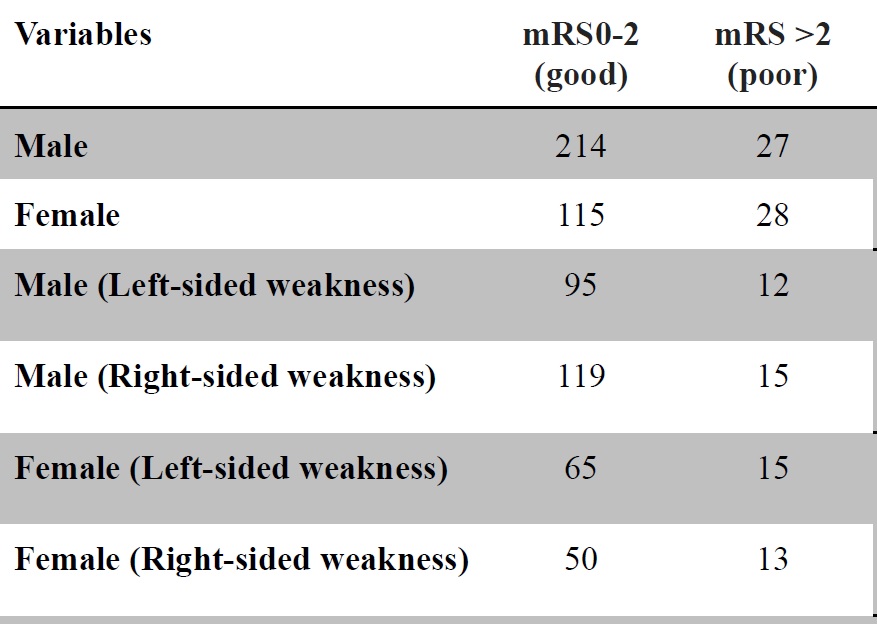Relationship among Sex, Pattern of Weakness and Treatment Outcomes of Post-Stroke Patients: A Register-Based Longitudinal Study
DOI:
https://doi.org/10.22502/jlmc.v10i1.456Keywords:
Health outcome, Right sided-weakness, Sex difference, Stroke, Stroke rehabilitationAbstract
Introduction: Differences in stroke care and health outcomes between males and females are debated globally. Sex differences in functional outcomes after stroke rehabilitation are poorly investigated in the context of Nepal. This study aimed to explore the relationship among patients’ sex, side of weakness, and post-stroke health outcomes after rehabilitation in a hilly western region of Nepal. Methods: A register-based longitudinal study was conducted in a rehabilitation center including all consecutive patients with stroke who came for rehabilitation ( ayurvedic, homeopathic, acupuncture, and physiotherapy ) from March 2018 to March 2020.
Modified Rankin Scale score at a three-month follow-up after a visit to the center was the main outcome measure. It was reported using relative risk and 95% confidence intervals. Results: The study included 384 stroke patients, among them 241 (62.8%) were males. Right-sided weakness was 1.262 times (RR =1.262, 95% CI = 1.016-1.567) more likely in males than in females. Male stroke patients were 1.104 times more likely to achieve a good outcome than females (RR=1.104, 95% CI = 1.007-1.211) and these findings were statistically significant. There was no association between the side of weakness and the outcome. Conclusion: More males,
compared to females, visited for rehabilitation and achieved a good outcome (mRS0-2) after three months. Right-sided weakness was more common in males than in females.
Downloads
References
GBD 2016 Stroke Collaborators. Global, regional, and national burden of stroke, 1990–2016: a systematic analysis for the Global Burden of Disease Study 2016. Lancet Neurol. 2019;18(5):439-58. PMID: 30871944 DOI: https://doi.org/10.1016/s1474-4422(19)30034-1
World Life expectancy. Nepal: Stroke [Internet].Available from: https://www.worldlifeexpectancy.com/nepal-stroke [cited 1st Jul 2020]
Jwarchan B, Yogi N, Adhikari S, Bhandari P, Lalchan S. A Study of Prevalence and Predictors of Acute Ischemic CVA Patients Admitted to Manipal Teaching Hospital, Pokhara, Nepal. Eastern Green Neurosurgery. 2020;2(1):42-6. DOI: https://doi.org/10.3126/egn.v2i1.27462
Haast RAM, Gustafson DR, Kiliaan AJ. Sex differences in stroke. J Cereb Blood Flow Metab. 2012;32(12):2100-7. PMID: 23032484DOI: https://doi.org/10.1038/jcbfm.2012.141
Kes VB, Jurašić MJ, Zavoreo I, Lisak M, Jelec V, Matovina LZ. Age and Gender Differences in Acute Stroke Hospital Patients. Acta clin Croat. 2016;55(1):69-78. PMID: 27333721DOI: https://doi.org/10.20471/acc.2016.55.01.11
Hametner C, Ringleb P, Kellert L. Sex and Hemisphere - A Neglected, Nature-Determined Relationship in Acute Ischemic Stroke. Cerebrovasc Dis. 2015;40(1–2):59-66. PMID: 26184600DOI: https://doi.org/10.1159/000430999
Gall S, Phan H, Madsen TE, Reeves M, Rist P, Jimenez M, et al. Focused Update of Sex Differences in Patient Reported Outcome Measures After Stroke. Stroke. 2018;49(3):531-5. PMID: 29438087DOI: https://doi.org/10.1161/strokeaha.117.018417
Hedna VS, Bodhit AN, Ansari S, Falchook AD, Stead L, Heilman KM, et al. Hemispheric Differences in Ischemic Stroke: Is Left-Hemisphere Stroke More Common? J Clin Neurol. 2013;9(2):97-102. PMID: 23626647DOI: https://doi.org/10.3988/jcn.2013.9.2.97
Renoux C, Coulombe J, Li L, Ganesh A, Silver L, Rothwell PM, et al. Confounding by Pre-Morbid Functional Status in Studies of Apparent Sex Differences in Severity and Outcome of Stroke.Stroke.2017;48(10):2731-8.PMID: 28798261DOI: https://doi.org/10.1161/strokeaha.117.018187
Willers C, Lekander I, Ekstrand E, Lilja M, Pessah-Rasmussen H, Sunnerhagen KS, et al. Sex as predictor for achieved health outcomes and received care in ischemic stroke and intracerebral hemorrhage: a register-based study. Biol Sex Differ. 2018;9(1):11.PMID: 29514685DOI: https://doi.org/10.1186/s13293-018-0170-1
Girijala RL, Sohrabji F, Bush RL. Sex differences in stroke: Review of current knowledge and evidence. Vasc Med. 2017;22(2):135-45.PMID: 27815349 DOI: https://doi.org/10.1177/1358863x16668263
Poggesi A, Insalata G, Papi G, Rinnoci V, Donnini I, Martini M, et al. Gender differences in post-stroke functional outcome at discharge from an intensive rehabilitation hospital. Eur J Neurol. 2021;28(5):1601-8. PMID: 33561883DOI: https://doi.org/10.1111/ene.14769
Sacco RL, Kasner SE, Broderick JP, Caplan LR, Connors JJB, Culebras An, et al. An Updated Definition of Stroke for the 21st Century: a statement for healthcare professionals from the American Heart Association/American Stroke Association. Stroke. 2013;44(7):2064-89.PMID: 23652265DOI: https://doi.org/10.1161/str.0b013e318296aeca
Specifications Manual for Joint Commission National Quality Measures (v2018A). Modified Rankin Score (mRS) [Internet].Available from: https://manual.jointcommission.org/releases/TJC2018A/DataElem0569.html [cited 8th June 2020]
Thapa A, Kc B, Shakya B, Yadav DK, Lama K, Shrestha R. Changing Epidemiology of Stroke in Nepalese Population. Nepal Journal of Neuroscience. 2018;15(1):10-18. DOI: https://doi.org/10.3126/njn.v15i1.20021
Hiraga A. Gender Differences and Stroke Outcomes. Neuroepidemiology. 2017;48(1–2):61–2. PMID: 28419999 DOI: https://doi.org/10.1159/000475451
Wang Q, MejÃa-Guevara I, Rist PM, Walter S, Capistrant BD, Glymour MM. Changes in Memory Before and After Stroke Differ by Age and Sex, but not by Race. Cerebrovasc Dis. 2014;37(4):235-43.PMID: 24686293DOI: https://doi.org/10.1159/000357557
Silasi G, Murphy TH. Stroke and the Connectome: How Connectivity Guides Therapeutic Intervention. Neuron. 2014;83(6):1354-68. PMID: 25233317DOI: https://doi.org/10.1016/j.neuron.2014.08.052
Towfighi A, Ovbiagele B, El Husseini N, Hackett ML, Jorge RE, Kissela BM, et al. Poststroke Depression: A Scientific Statement for Healthcare Professionals From the American Heart Association/American Stroke Association. Stroke. 2017;48(2):e30-43.PMID: 27932603DOI: https://doi.org/10.1161/str.0000000000000113
Phan HT, Blizzard CL, Reeves MJ, Thrift AG, Cadilhac D, Sturm J, et al. Sex Differences in Long-Term Mortality After Stroke in the INSTRUCT (INternational STRoke oUtComes sTudy): A Meta-Analysis of Individual Participant Data. Circ Cardiovasc Qual Outcomes.2017;10(2):e003436.PMID: 28228454DOI: https://doi.org/10.1161/circoutcomes.116.003436
Cordonnier C, Sprigg N, Sandset EC, Pavlovic A, Sunnerhagen KS, Caso V, et al. Stroke in women - from evidence to inequalities. Nat Rev Neurol. 2017;13(9):521-32.PMID: 28731036DOI: https://doi.org/10.1038/nrneurol.2017.95
Carcel C, Woodward M, Wang X, Bushnell C, Sandset EC. Sex matters in stroke: A review of recent evidence on the differences between women and men. Front Neuroendocrinol. 2020;59:100870.PMID: 32882229DOI: https://doi.org/10.1016/j.yfrne.2020.100870
Bushnell C, Howard VJ, Lisabeth L, Caso V, Gall S, Kleindorfer D, et al. Sex differences in the evaluation and treatment of acute ischaemic stroke. Lancet Neurol. 2018;17(7):641-50. PMID: 29914709DOI: https://doi.org/10.1016/s1474-4422(18)30201-1

Downloads
Published
Issue
Section
License
- The Journal of Lumbini Medical College (JLMC) publishes open access articles under the terms of the Creative Commons Attribution (CC BY) License which permits use, distribution and reproduction in any medium, provided the original work is properly cited.
- JLMC requires an exclusive licence to publish the article first in its journal in print and online.
- The corresponding author should read and agree to the following statement before submission of the manuscript for publication,
- License agreement
- In submitting an article to Journal of Lumbini Medical College (JLMC) I certify that:
- I am authorized by my co-authors to enter into these arrangements.
- I warrant, on behalf of myself and my co-authors, that:
- the article is original, has not been formally published in any other peer-reviewed journal, is not under consideration by any other journal and does not infringe any existing copyright or any other third party rights;
- I am/we are the sole author(s) of the article and have full authority to enter into this agreement and in granting rights to JLMC are not in breach of any other obligation;
- the article contains nothing that is unlawful, libellous, or which would, if published, constitute a breach of contract or of confidence or of commitment given to secrecy;
- I/we have taken due care to ensure the integrity of the article. To my/our - and currently accepted scientific - knowledge all statements contained in it purporting to be facts are true and any formula or instruction contained in the article will not, if followed accurately, cause any injury, illness or damage to the user.
- I, and all co-authors, agree that the article, if editorially accepted for publication, shall be licensed under the Creative Commons Attribution License 4.0. If the law requires that the article be published in the public domain, I/we will notify JLMC at the time of submission, and in such cases the article shall be released under the Creative Commons 1.0 Public Domain Dedication waiver. For the avoidance of doubt it is stated that sections 1 and 2 of this license agreement shall apply and prevail regardless of whether the article is published under Creative Commons Attribution License 4.0 or the Creative Commons 1.0 Public Domain Dedication waiver.
- I, and all co-authors, agree that, if the article is editorially accepted for publication in JLMC, data included in the article shall be made available under the Creative Commons 1.0 Public Domain Dedication waiver, unless otherwise stated. For the avoidance of doubt it is stated that sections 1, 2, and 3 of this license agreement shall apply and prevail.
Please visit Creative Commons web page for details of the terms.












